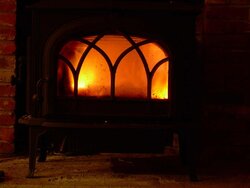Hi everyone...yeah, I'm new, but I've read a load of the FAQs and a lot of the topics to try to not sound like a complete moron. I really need some help. I've got a new Oslo, great stove - but I'm so new to wood heat and timid about mistakes and anal about trying to make the stove work as if it's on a thermostat that I need some experienced help. Unfortunately, my questions are going to sound pretty dumb. Sorry in advance.
First things first...it's installed great. Great draft, easy to fire up, virtually no visible smoke coming out of the chimney. Something's going right.
Here's the problem...I can't get any kind of consistent temperature out of it (it's up - I shut the air thingie by a fraction ---- it's down - I open the air thingie by a fraction). Geez, I'm spending all day long running up and down the basement stairs to watch my wood stove like a hawk. I'm really afraid of getting it too hot. I did the break-in the right way. I've had it as high as about 610 (thermometer on the back right corner of the stove top) but I'm afraid to go any higher than that as the instructions say the optimum is 400-600. Also, the helpful little color coded thing on the thermometer basically has 600 very near the "overfire" range. The stove isn't going to do me much good if it burns consistently around 300-350. But that's what I'm getting when I try to damp it down so it won't rise on me. I'm afraid if it starts to rise, it won't know when to stop. So, literally, every 10 minutes I'm stopping what I'm doing (baking brownies) to run to the basement to eyeball that thing again. To ask someone "where do you set the air control thingie" is a dumb question, I know. But there's got to be some sort of method to this.
Any help is most appreciated. I might bake you a brownie. Thanks in advance...
Karyn
First things first...it's installed great. Great draft, easy to fire up, virtually no visible smoke coming out of the chimney. Something's going right.
Here's the problem...I can't get any kind of consistent temperature out of it (it's up - I shut the air thingie by a fraction ---- it's down - I open the air thingie by a fraction). Geez, I'm spending all day long running up and down the basement stairs to watch my wood stove like a hawk. I'm really afraid of getting it too hot. I did the break-in the right way. I've had it as high as about 610 (thermometer on the back right corner of the stove top) but I'm afraid to go any higher than that as the instructions say the optimum is 400-600. Also, the helpful little color coded thing on the thermometer basically has 600 very near the "overfire" range. The stove isn't going to do me much good if it burns consistently around 300-350. But that's what I'm getting when I try to damp it down so it won't rise on me. I'm afraid if it starts to rise, it won't know when to stop. So, literally, every 10 minutes I'm stopping what I'm doing (baking brownies) to run to the basement to eyeball that thing again. To ask someone "where do you set the air control thingie" is a dumb question, I know. But there's got to be some sort of method to this.
Any help is most appreciated. I might bake you a brownie. Thanks in advance...
Karyn


 !
! 